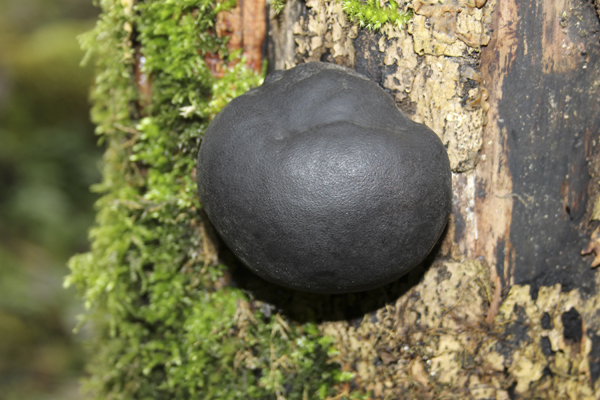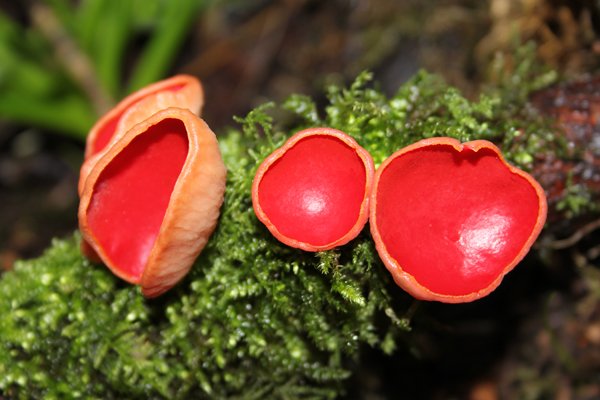Seventeen MNA members joined our first coach trip of the year to the Lancashire Wildlife Trust Nature Reserve at Brockholes just off the M6. Given the recent prolonged heavy rains exceptional foresight was shown by Adam Khan architects design of the visitor centre named ‘A Floating World’ comprising of a cluster of buildings based on an ancient marshland village that floats amongst the reedbeds on one of the site’s lakes.
After looking around the visitor centre and a couple of members talking to BBC Lancashire Local Radio about our visit we braved the blustery winds and drizzle and headed off. I became side-tracked looking at fungi on the twig fence leading down to the visitor centre from the car-park finding Exidia plana – a shiny black gelatinous fungi with individual fruit-bodies blending into one another like the folds of a brain; Waxy Crust Vuilleminia comedens – a grey resupinate fungi with purple tinges growing beneath the bark on dead branches causing the bark to characteristically roll-back and Tukeytail Trametes versicolor. On looking up the group had disappeared! However upon catching up with everyone at the end of the day we seemed to have seen most of the same species.
Exidia plana
Waxy Crust
The lakes held resident and winter wildfowl with Canada Geese, a few Mute Swans, Grey Heron, Mallard, Teal, Gadwall, Tufted Duck, Great Crested Grebe, a couple of male Shovelers, a pair of Goldeneye and a motley collection of Cormorants stood in line on the edge of one of the islands. The feeding table had a male Pheasant and Woodpigeon perched on top, Mallards hovering up any spilt feed, along with Chaffinch and Great Tits. The woodland was productive with singing Wrens, Dunnocks, Robins and Blackbirds; Great and Blue Tits, Goldcrest, Nuthatch and Treecreeper. John Clegg’s group noted flowering Snowdrops in the woodland.
I spent most of the day scrambling about the fallen and felled trees in the ancient woodland of Red Scar Wood where I found a scattering of Fungi. Jelly Ear Auricularia auricula-judae – large numbers of this common pinkish brown ear-shaped gelatinous fungi growing on Elder, Common Inkcap Coprinus atramentarius, Glistening Inkcap Coprinus micaceus – dense clusters of this tawny-coloured bell-shaped Fungi growing on a fallen log.
Jelly Ear
Glistening Inkcap
King Alfred’s Cakes Daldinia concentrica the common ball-shaped Fungus usually found on dead wood of ash trees, Velvet Shank Flammulina velutipes this common bright orange winter Fungi was growing in clusters on a few deciduous tree stumps, Crystal Brain Exidia nucleata, Beech Woodwart Hypoxylon fragiforme – with small warty brown growths swarming over dead branches of Beech.
King Alfred’s Cakes a.k.a. Cramp Balls
Beech Woodwart
Rosy Crust Peniophora incarnata and also Peniophora quercina a pinkish resupinate fungus growing on Oak branches, Honey Fungus Armillaria mellea one fallen tree was covered in the black bootlace like flattened rhizomorphs of Honey Fungus that develop beneath the bark and Jelly Rot Phlebia tremellosa.
Peniophora incarnata
Peniophora quercina
Honey Fungus rhizomorphs
Find of the day was Scarlet Elfcup Sarcoscypha austriaca – a friend had noted seeing lots of these recently at nearby Leighton Moss RSPB reserve so I was hopeful I’d see some today. I spotted my first group of these bright red cup-shaped beauties close to the path – Dave Bryant’s group also saw these particular ones. The inside of the cup is smooth whereas the outside has whitish hairs that are curly or corkscrew shaped. With more searching I found four cups in pristine condition 🙂
Scarlet Elfcup
Also noted was Bleeding Oak Crust Stereum gausapatum, Bleeding Broadleaf Crust Stereum rugosum, Hairy Curtain Crust Stereum hirsutum, Lumpy Bracket Trametes gibbosa, Yellow Brain Tremella mesenterica – a yellow gelatinous mass of lobes and folds sometimes called Yellow Witches Butter and Candlesnuff Fungus Xylaria hypoxylon.
Lichen covered a number of the smooth-barked trees these included Lecidella elaeochroma f. elaeochroma – an early colonist with an grey thallus and small black spot-like apothecia and Lecanora chlarotera – with crustose grey thallus and apothecia with thick margins and buff brown discs.
Tree Lichens
If you are interested in the wildlife of the north-west of England and would like to join the walks and coach trips run by the Merseyside Naturalists’ Association, see the main MNA website for details of our programme and how to join us.
A wide photographic selection of birds, marine life, insects, mammals, orchids & wildflowers, fungi, tribal people, travel, ethnography, fossils, rocks & minerals etc. is available on my Alamy webpage











